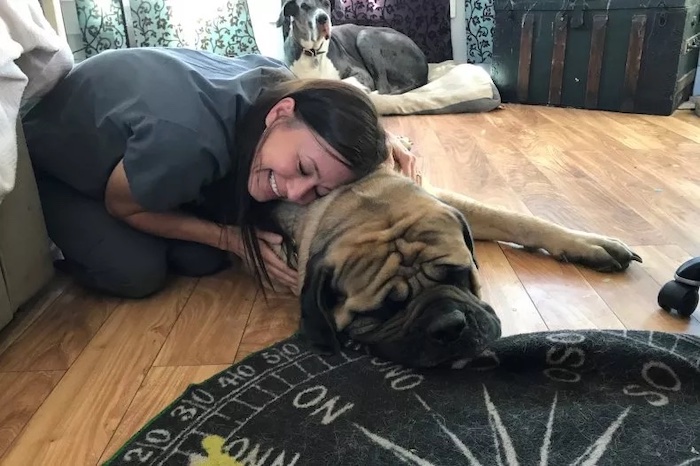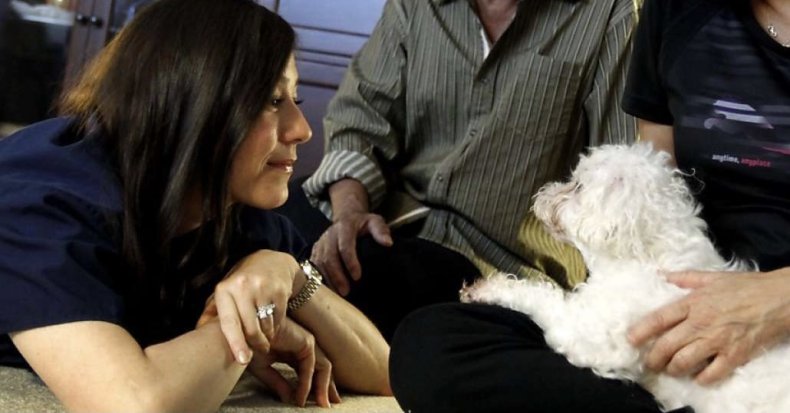
By Dr. Shea Cox
I didn’t grow up with pets but I remember wanting to be a vet since I was 8 years old and working on my stuffed animals as if they were patients. I went into college wanting to be a vet but I failed chemistry three times and ended up going to art school.
In 1991, I moved to LA on a whim. I was broke and looking for a job and ended up working in a nursing home. That led me to nursing school and chemistry started to click. I worked in areas of home hospice and palliative care. That dream never left and I began to think that maybe I could be a vet.
I started taking my prerequisite classes for vet school, and I continued nursing actually to pay my way through vet school. I finally graduated vet school in 2001 and went directly into emergency and critical care.
I spent 13 years working in a veterinary ER, and during this time, our care evolved and we became a specialty hospital with internal medicine and oncology. I started to see that during the most critical time in people’s relationship with their pet, when pets were ill or had multiple comorbidities, people would need more time to process complex issues and decisions and they weren’t getting it. We would diagnose their pet with cancer in the ER and people would be left in that state of shock.
I felt like we were failing, and I decided I was going to start offering services strictly focused on hospice and palliative care for pets. But in 2012, when I started offering three hour in-home appointments, people told me that the idea wasn’t financially viable. I said I was going to try. I felt in my heart it was what people and pets needed.
My first hospice patient was a dog named Sunny. Sunny was brought into our veterinary ER with multiple urinary issues by her owner’s fiance, because he was in Colorado at his father’s funeral. I did an exam and discovered it was a tumor that was blocking the urethra so the pet wasn’t able to urinate. It was a situation that is technically one where we would euthanise the animal. But I discovered that Sunny was the pet that had got the owner through his wife’s death. I so clearly remember being in the ER and finding all of this out about the owner and realizing that he could not come back to be with Sunny and say goodbye.
I ended up providing Sunny with an in-dwelling urinary catheter, something which should be in-hospital only. I remember others saying we couldn’t send Sunny home with this catheter, but the alternative was euthanasia, breaking this human/animal bond, not allowing the owner to say goodbye.
Sunny was able to go home and three days later the owner returned and they spent an amazing two weeks together. They managed the catheter and completed their bucket list. Sunny swam in the ocean with her owner and they had a huge party with other dog friends where they ate grilled filet mignon and had these “pupsicle” ice creams. We were able to facilitate a goodbye on the lawn of his house. To be able to create that kind of goodbye for someone, when the alternative would be so different, was life changing for me as a person and a doctor. That is a situation that has lived with me and been my north star since I started this.
For me, hospice and palliative care begins at the time of diagnosis, when there are signs of decline in the pet, because there is so much we can do to improve quality of life and prepare the pet and pet parent. We have had pets in hospice for 18 month to 2 years, so that’s technically palliative care.
Hospice care is done in the pet’s home. We are under the umbrella of the Pearl Pet Hospice but our goal is to be that bridge between the hospital and the home. One of the things I found interesting early on in these 3 hour in-home appointments was that 75 percent of the care people needed help with was non-medical.
Families typically need help planning and goal setting for how they wanted their pet’s end of life to look, help deciding what their bucket list was going to be, whether they wanted a memorial. We discuss what they are struggling with and what their resources are. A lot of the topics are things vets aren’t typically able to address with families because there’s just not the time.
When a family enters their pet into our hospice program, they have an entire team on their side to support them every step of the way. Families work with me, a dedicated nursing team, care coordinators and pet loss support specialists. During our in-home appointment, we educate and empower the family, including in how to recognize signs of decline, how to give medications or injections, and how to monitor progression of their pet’s disease. Following this, the majority of our care continues virtually via telehealth where the family has 7-day a week access to their hospice team for guidance and support until the time of in-home euthanasia. Generally, the pet’s quality of life sky rockets, and the time to euthanasia is generally much farther out than what their pet’s diagnosis would dictate. I’m surprised every day by the difference we can make, and that just makes my heart so full.

The vast majority of my hospice patients are dogs and cats, it is a little more weighted towards dogs, which is surprising since cats don’t generally like to go into hospitals as much. I have had a couple of bird patients. When birds can live for 80 years, people are very bonded to them.
I have helped thousands and thousands of pets in hospice care. I have been doing this close to 10 years and as we have grown as a team, we’ve been able to affect a lot of lives, which is amazing.
Over the past 10 to 15 years I think the human/animal bond has changed dramatically. Millennials are now the largest pet owning population and their pets are their children. When I started this in 2012 in the Bay Area of California, there were four other practices doing something similar. Now I believe there are close to 30. That area may have a unique demographic that supports that but I am seeing this trend across the country.
Pet hospice care is growing pretty rapidly. It has been widely known for around 10 years and in the past five years there has been a large increase of practitioners. The International Association of Animal Hospice and Palliative Care (IAAHPC) is an organization where in the earlier days there were just a couple of hundred of us and now there are close to 2,000 members.
People often say they wish they had known about this for their last pet, or
sooner, and that’s something I want to erase from people’s thoughts. I want everyone to know this is available. The other thing I hear a lot is people asking me how I can do this every day, because it must be so sad and make me depressed. Oddly it’s just the opposite. I spent 13 years in the ER doing everything I could to save lives and I have never been so gratified as being able to end them well. People are so grateful that you are taking the time with them and being caring during one of the most intimate times in their relationship with their animals. Of course, it is sad and I still get teary at every euthanisia, but I leave with my heart so full that it’s hard to say this is anything but the most amazing career in the world.
Complete Article ↪HERE↩!
